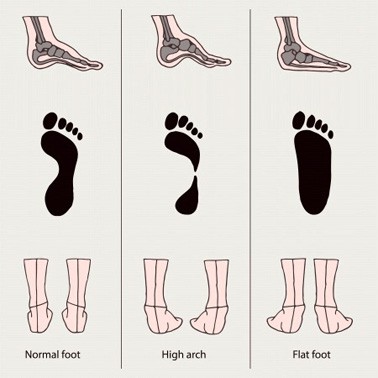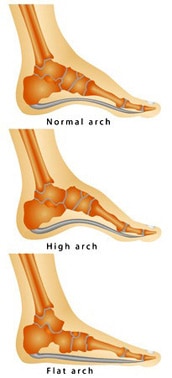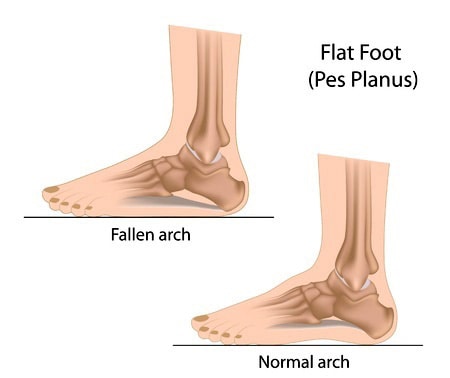Fallen Arches and Flat Feet
Fallen Arches and Flat Feet Symptoms, Causes and Treatment
What Are Fallen Arches?
A normal arch would naturally create an upward curve within the middle of the human foot. Ligaments and tendons within the lower foot area will help in forming the arch and stabilizing it. The foot is important because it helps to support your whole body. Strong arches are mandatory to support your foot in carrying your body weight. Weak tendons and ligaments would naturally collapse the arch.
Acquired flat foot disorder is the result of a collapsed arch. The sole of your foot shouldn’t touch the ground completely when you are standing. Nevertheless, a fallen arch will cause your foot to roll inwards and the entire sole would come close to touching the ground. Our feet are considered the foundation of our body. Hence, flat feet can cause problems with the skeletal structure and bring the joints out of alignment.
Fallen arches would weaken the ligaments and tendons and cause intense pain throughout the lower leg muscles, ankle, and feet and in the region of the heel. This could result in a weakened posture and discomfort through the lower backs and hips.

What Causes Fallen Arches & Flat Feet?
Fallen arches and flat feet could be caused due to an abnormality during childhood where the foot arches never forms. It could also be hereditary. Excessive foot stress may cause the condition among adults too. Failing to treat foot injuries such as ankle sprains could lead to this foot condition. Some prominent cases of excessive foot stress include:
- Weight gain or aging can result in weakened muscles in the ankle, lower leg and ankle.
- Walking and standing for extended periods, especially in dress shoes or heels.
- Wearing shoes that are quite uncomfortable and without proper arch support.
- Broken bones and ankle sprains.

Symptoms of Fallen Arches or Flat Feet
Many people with flat feet don’t experience any symptoms. However, in some cases, flat feet can cause foot pain, particularly in the heel or arch area. The pain might worsen with activity. Swelling along the inside of the ankle can also occur. It’s important to note that if you’re experiencing foot pain and it’s not improving, you should seek medical attention.
This condition will not go away on it own and may begin to insert pressure and strain on your knees and ankles. The ligaments and tendons between the knees and feet become stressed, which would lead to discomfort within the lower body joints.
Over time, fallen arches could result in serious problems in your body’s alignment. The angle of the joints in the hips, ankle, and knees would change slightly due to the condition. This can cause excess strain on the joints.
Continuous strain on the ligaments and tendons that support the arch and ankle of your foot could cause the bones to collapse, which could lead to:
- Severe heel pain when walking or standing after some rest.
- Knee and ankle pain due to misaligned joints.
- Slow development of arthritis.
- Lower back and hip pain due to the inability of absorbing shock properly.

Foot Examination and Podiatrist Diagnosis
People suffering from this condition would find their instep of the foot contacting with the ground while standing. A foot doctor will ask you to stand on your toes in order to diagnose this condition. If there is an arch formed while you are standing on the toes, it is called flexible flat feet and will not require further testing or treatment.
If there is no arch while you are standing on the toes, it is referred to as rigid flat feet, which may require further testing such as:
- X-Ray of the foot
- To look at the bones in your foot, a CT Scan may be recommended.
- To examine the tendons of your foot, an MRI may be recommended.
Non-Surgical Treatment Options
Non-surgical treatment options may include the following:
- Supportive and comfortable shoes with the best insoles for flat feet that fully support the arch and stabilize the heel should be worn by the patient. This should be practiced while at work and during sporting activities.
- Orthotics that helps to minimize and distribute the pressure of the foot should be worn at all times by such patients. The Orthotics will also help to realign the foot’s bones and ankle joints. They are custom-designed to fit your feet and would provide extra support while standing, walking and running.
- The doctor will advise you about the best insoles and arch supports. Arch inserts and wraps could be used when wearing shoes that lack proper arch support. The arch supports for flat feet would help to eliminate the pain and discomfort of the foot and allow you to stay longer on your feet.
Surgical Treatment Options
If you are not getting the intended benefits by using non-surgical treatments, surgery could be an option. Flat foot disorder in older people could be relieved with painkillers, orthotics, or surgery. Surgery will help to stabilize the anklebone and foot and also help with foot support.
- The podiatrist will first check your rigid flat feet to determine the cause of it before deciding on the treatment method.
- If the cause is tarsal coalition (an abnormal connection between the tarsal bones of the foot), the treatment will start with rest and relaxation.
- Surgery may be recommended if the pain doesn’t improve.
In more severe cases, surgery may be recommended to:
- Clean and then repair the tendon.
- Fusing the joints in the foot into a corrected position.
All Foot & Ankle Conditions We Treat
Advanced Foot & Ankle Solutions
Have Questions or Need Care?
We’re here to help! Schedule your appointment online now for fast and easy care.
